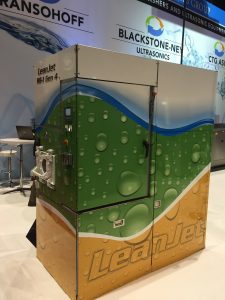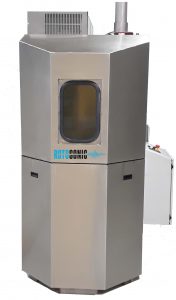 Cleaning Technologies Group (CTG), headquartered in Cincinnati, Ohio, is made up of three divisions. Ransohoff, a manufacturer of aqueous parts washers, has been doing so for more than a century. Blackstone-NEY Ultrasonics designs and manufactures industrial and precision ultrasonic cleaning equipment, harnessing environmentally sound solutions for challenging parts cleaning applications. These technologies utilize multiple frequency and waveform ultrasonic generators. It is located in Jamestown, New York. Finally, CTG Asia, in Suzhou, China, was formed in 2007, building Ransohoff and Blackstone-NEY equipment for that market in its new, high-tech facility.
Cleaning Technologies Group (CTG), headquartered in Cincinnati, Ohio, is made up of three divisions. Ransohoff, a manufacturer of aqueous parts washers, has been doing so for more than a century. Blackstone-NEY Ultrasonics designs and manufactures industrial and precision ultrasonic cleaning equipment, harnessing environmentally sound solutions for challenging parts cleaning applications. These technologies utilize multiple frequency and waveform ultrasonic generators. It is located in Jamestown, New York. Finally, CTG Asia, in Suzhou, China, was formed in 2007, building Ransohoff and Blackstone-NEY equipment for that market in its new, high-tech facility.
According to Dave Melton, marketing manager at CTG, so many factors must be taken into consideration when determining the best parts washing system for a particular operation that the vast majority of its systems are custom made. “These variables include the geometry of the part, the angles involved, the temperature of the solution being used — and the temperature of the part as it enters the washer — the degree of cleaning required, the material in use, and the number of change-outs that will be performed,” he says.”Even surface conditions must be taken into consideration, as lapped parts will need a longer ultrasonic bath to remove particulates from the grooves than would a smoother, less-striated finish.”
 In metalworking, there are four basic methods to performing water-based cleaning operations: standard spray, total immersion, ultrasonics, and high-pressure spray. The two spray processes are called “line of sight,” as the spray will clean all features that can actually be seen with the naked eye. Immersion and ultrasonics are required for more complex geometries with angles and deep pockets that require a more cleaning penetration to get the job done. Total immersion can also be combined with the parts being spun or agitated, if need be.
In metalworking, there are four basic methods to performing water-based cleaning operations: standard spray, total immersion, ultrasonics, and high-pressure spray. The two spray processes are called “line of sight,” as the spray will clean all features that can actually be seen with the naked eye. Immersion and ultrasonics are required for more complex geometries with angles and deep pockets that require a more cleaning penetration to get the job done. Total immersion can also be combined with the parts being spun or agitated, if need be.
A quick review of how these processes are performed, and how they differ, is useful, along with a look at the latest CTG advances available on the market.
- Standard spray is a simple, straightforward process that is ideal for a wide variety of manufacturers, providing flexibility among parts of different shapes, materials and sizes in general industry. Parts are positioned on a rotary table and sprayed with water containing different concentrations of surfactant to clean oil and other contaminants from the surface of the part. Remaining liquid is then blown off using compressed air. More acidic cleaners are used with soft metals such as copper, brass and bronze, while steel products require that attention be paid to the pH level. A solution with a pH of less than seven is considered acidic, while a solution with a pH higher than seven is referred to as basic, or alkaline.
- Total immersion is generally considered first when features or deep recesses on the part prevent direct line of sight inspection. Cutting fluids, chips and other particulate matter can evade even high-pressure spraying, so some parts must be fully immersed in the cleaning solution. Parts can be loaded into a basket and then into the cleaning chamber and sprayed while the basket is rotated. The chamber is filled while the basket is plunged into the bath, agitated, and then withdrawn, penetrating the part’s recesses. Automation can be incorporated into any of these processes.
- Ultrasonics can be combined with the standard spray and total immersion processes, adding cavitation to the cleaning system. Once spraying has been completed to remove gross contaminants, the chamber is filled and high-intensity sound waves are introduced into the solution, forming vacuums within the crevasses of the parts being cleaned. Depending on the frequency of the sound waves, contaminants are removed at the lower end of the scale while material can actually be removed from the part surface at higher exposures. Ultrasonic cleaning is ideal for aerospace and medical markets that have the strictest requirements.
- High-pressure spray is primarily used for deburring applications, removing burrs without damaging the underlying substrate. With an upper range of 10,000 psi, the Ransohoff line of high-pressure washers generally operate in the 3,500-psi range for materials such as aluminum and approximately 5,000 psi for parts made of steel.
CTG offers laboratory testing to ensure that the final customer specifications for cleanliness are met. The company’s tech center houses a cleanroom rated at class 10,000 using gravimetric filters to conduct microscopic particle size analysis.
 As is the case with any OEM, CTG has worked to incorporate new streamlining into its designs, bringing multitasking and robotics into the process. The Rotosonic ultrasonic cleaning system is an automated, all-in-one machine that uses high-pressure spray, part rotation, and ultrasonic energy to clean parts within a single machine. It is ideal for automotive maintenance, rebuilding and restoration, as well as transmission and engine rebuilders and aerospace remanufacturing. The Ransobotic TT-180 combines robot-operated spray nozzles and a precision worktable to help users meet their complex parts washing requirements. A Fanuc LR-Mate robot and Siemens programmable controls make operation fast and efficient. The Robosonic is a robotic automated cleaning cell that features a four-tank system incorporating a spray wash, ultrasonic immersion wash, an ultrasonic rinse tank, and a dryer. Flexible part processing is provided by a Fanuc CR-7i robot or optional collaborative robot. This unit was designed for clean room and precision parts cleaning applications.
As is the case with any OEM, CTG has worked to incorporate new streamlining into its designs, bringing multitasking and robotics into the process. The Rotosonic ultrasonic cleaning system is an automated, all-in-one machine that uses high-pressure spray, part rotation, and ultrasonic energy to clean parts within a single machine. It is ideal for automotive maintenance, rebuilding and restoration, as well as transmission and engine rebuilders and aerospace remanufacturing. The Ransobotic TT-180 combines robot-operated spray nozzles and a precision worktable to help users meet their complex parts washing requirements. A Fanuc LR-Mate robot and Siemens programmable controls make operation fast and efficient. The Robosonic is a robotic automated cleaning cell that features a four-tank system incorporating a spray wash, ultrasonic immersion wash, an ultrasonic rinse tank, and a dryer. Flexible part processing is provided by a Fanuc CR-7i robot or optional collaborative robot. This unit was designed for clean room and precision parts cleaning applications.
While this provides a mile-high view of CTG’s extensive product lineup, as well as the latest additions to its technological offerings — all detailed clearly and completely on its website — the real experience involves the attention paid to determining a customer’s needs at the front end, Melton says. “It’s critical that we ask all the right questions going in,” he says, “because that’s how we’ll get the right outcome on the other end from the very beginning.”


















